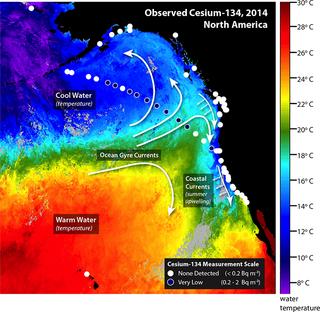Fukushima Radiation Traces Found In West Coast Waters

Tuesday, November 18 2014

In this illustration of ocean currents, white dots indicate where no cesium-134 was detected. Blue dots indicate locations were low levels of cesium-134 were detected farther offshore. /Courtesy: WHOI
Coastal Alaskans have been watching for signs of radiation from 2011’s Fukushima nuclear plant accident in Japan. Now, an oceanography institute says trace amounts have been detected off the West Coast. Radiation experts say the very low levels of measured do not pose a health threat here.
The post-earthquake and tsunami nuke plant accident spilled a large amount of radioactive contamination into the Pacific three years ago.
Oceanographers projected that it would take until this year for highly diluted traces to reach the West Coast of North America. And ta-da, a recent research cruise from Unalaska to Eureka, Calif. detected the front edge of the plume multiple times between 100 and 1,000 miles offshore.
"The levels offshore still are quite low," says Ken Buesseler, a senior scientist at the Woods Hole Oceanographic Institution. "So by that I mean they are a couple units of these Becquerels per cubic meter, something that is about a thousand times less than a drinking water standard."
Buesseler says he is reluctant to "trivialize" any amount of radiation, but says he personally has no concerns about swimming, boating or eating fish from local waters.
Since the start of this year, Buesseler's lab has also tested about 50 seawater samples collected at the shore by concerned coastal residents from California to Alaska. All of those results have come up negative. This sampling was paid for through crowdfunding as part of an ongoing "citizen science" monitoring project initiated by Buesseler.
A parallel but independent monitoring effort run through the radiation health lab at Oregon State University found no detectable traces of Fukushima radiation in seawater samples collected earlier this year in near shore waters along the Pacific Northwest coast.
Scientists tracking the plume from Japan look for a short-lived cesium isotope, cesium-134, that serves as the "fingerprint" of Fukushima contamination.
For context, radioecologist Delvan Neville at OSU said it helps to know that the cesium-134 levels reported by the Woods Hole researcher are "much less than the natural background radiation in seawater." In an interview, Neville was certain the low levels of Fukushima-derived isotopes detected in the northeastern Pacific do not pose an environmental or human health radiological threat.
The results Buesseler reported corroborate detections of cesium-134 in seawater far offshore from Vancouver Island starting last year. Scientists from Fisheries and Oceans Canada, Health Canada and the University of Victoria are collaborating on a monitoring effort that also includes fish sampling.
None of the salmon, halibut, sablefish and spiny dogfish they have analyzed have contained detectable levels of radiation traceable to Fukushima.
This story was originally reported for the Northwest News Network.


